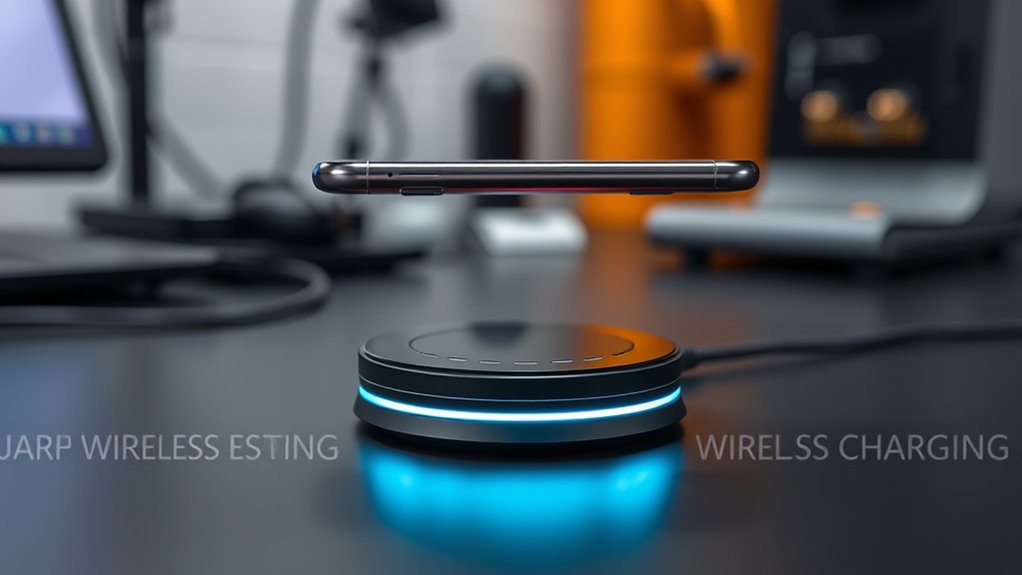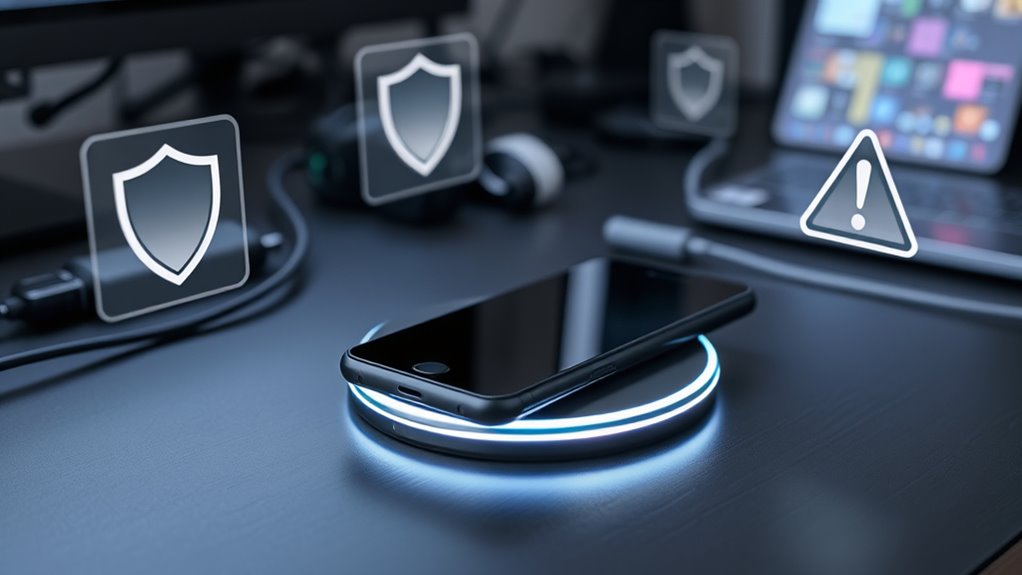Wireless charging is generally safe when you use certified devices, but many myths persist. Some believe electromagnetic fields can interfere with your electronics or harm your health, but modern chargers meet strict emission limits to prevent this. Heat buildup can affect your battery, so proper placement and quality chargers matter. Using uncertified or low-quality chargers increases risks of interference and overheating. To understand the facts behind wireless charging safety and how to protect your devices, keep exploring these important points.
Key Takeaways
- Modern wireless chargers comply with safety standards, minimizing electromagnetic interference with nearby devices.
- Proper device placement and certified chargers reduce heat buildup and prevent battery degradation.
- Electromagnetic fields from certified chargers are within safe limits and unlikely to cause health issues.
- Using high-quality, certified chargers ensures safety and reduces interference risks.
- Excessive heat during charging can accelerate battery wear, so proper use and cooling are essential.

Wireless charging offers convenience, but it’s important to understand the safety considerations involved. One of the main concerns many people have is electromagnetic interference, which occurs when the wireless charging pad emits electromagnetic fields that might disrupt nearby electronic devices or even affect your health. While electromagnetic interference is a valid point to consider, modern wireless chargers are designed with safety standards that minimize such risks. They operate within regulated electromagnetic emission limits, ensuring that the fields produced are safe for everyday use and unlikely to cause interference with other electronics like pacemakers or hearing aids. However, if you notice any unusual device behavior when charging, it’s wise to check for potential interference issues and consult the device manufacturer.
Another common worry revolves around battery degradation. You might wonder whether wireless charging accelerates the wear and tear on your device’s battery compared to traditional wired charging. The truth is, wireless charging can generate more heat during the process, and excessive heat is a known factor that contributes to faster battery aging. That said, most modern devices and chargers incorporate temperature management features designed to keep heat levels in check, thereby reducing the risk of battery damage. To prolong your battery’s lifespan, avoid using wireless chargers in hot environments and prevent charging your device to 100% or letting it drain completely. Keeping your device within a moderate charge range and allowing it to cool down during charging sessions helps mitigate battery degradation over time.
Additionally, understanding how contrast ratio impacts image quality can help you make better choices when selecting wireless charging devices, as the safety features of reputable chargers include clear indicators and safeguards to prevent overheating and damage. It’s also worth noting that while wireless chargers are generally safe, poor-quality or uncertified devices might not adhere to safety standards. Using incompatible or counterfeit chargers can increase electromagnetic interference or cause overheating, both of which pose safety risks. Always opt for reputable brands and certified chargers that meet safety regulations. Proper placement of your device on the charging pad is equally important; ensure it’s aligned correctly to avoid uneven heating or potential damage.
Frequently Asked Questions
Can Wireless Chargers Cause Electromagnetic Interference With Other Devices?
Wireless chargers can cause electromagnetic interference, but it’s usually minimal and unlikely to disrupt other devices. You might notice some interference with sensitive electronics, but most modern chargers are designed to be compatible and reduce this risk. To avoid device compatibility issues, keep your wireless charger properly positioned and use certified products. Overall, electromagnetic interference from wireless chargers isn’t a significant concern if you follow recommended safety guidelines.
Are Wireless Charging Pads Safe for Use Around Children and Pets?
Imagine a tiny toddler or a curious pup eyeing your wireless charging pad like it’s a new chew toy. Rest assured, these pads are generally safe around children and pets, especially if you keep them out of reach. To guarantee child safety and pet protection, avoid leaving devices unattended and use covers or barriers. With these precautions, you can relax knowing your tech isn’t turning into a perilous playground.
Do Wireless Chargers Emit Harmful Radiation With Prolonged Use?
You might wonder if wireless chargers emit harmful radiation with prolonged use. They do produce electromagnetic exposure, but at levels well within radiation safety standards. This low electromagnetic exposure is unlikely to cause health issues over time, making wireless charging safe for daily use. Rest assured, as long as you use certified chargers, you’re not at risk of harmful radiation, and your devices remain safe during extended charging sessions.
Is There a Risk of Overheating or Fire From Wireless Charging?
When it comes to wireless charging, it’s not a case of crying wolf, but thermal concerns do matter. While most chargers are designed with safety features, there’s still a slight risk of overheating, which could lead to fire hazards if not used properly. To stay safe, avoid charging on soft surfaces, keep your device cool, and use certified chargers. This way, you minimize the chances of overheating or fire risks.
Can Wireless Charging Damage My Device’s Battery Over Time?
You might worry about wireless charging damaging your battery over time, but it generally doesn’t cause significant battery degradation if used correctly. Wireless chargers maintain good charging efficiency, reducing strain on your device’s battery. However, frequent, prolonged wireless charging can contribute to wear. To protect your battery, avoid overcharging and use high-quality chargers. Proper use helps extend your battery’s lifespan without risking damage from wireless charging.
Conclusion
Now that you know the facts about wireless charging safety, you can confidently use your devices without worry. Don’t let myths scare you off—most concerns are blown out of proportion. As with anything, staying informed is your best bet. Remember, knowledge is power, and in this case, it keeps you safe. So go ahead, charge up and stay connected—just keep your eyes open and don’t let false information steer you wrong.









